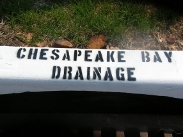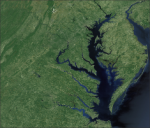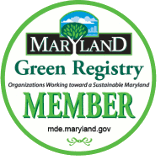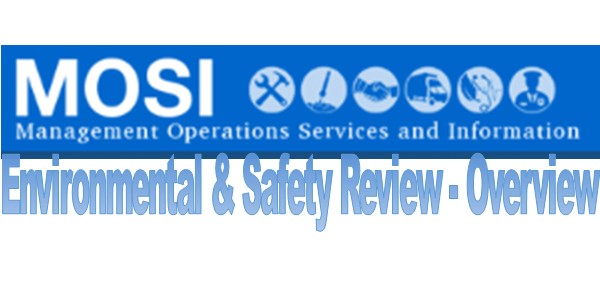Storm Water Management
Clean Water Program
- Introduction to Storm Water
-
Introduction to Stormwater
 Stormwater runoff is rain and snowmelt that flows over impervious surfaces, such as parking lots, building rooftops, and roads. In undeveloped areas, stormwater infiltrates the ground and replenishes aquifers, is absorbed by plants, or meanders through the landscape to surface waters. In developed areas, stormwater cannot soak through the ground. Instead it cascades over hard surfaces and becomes contaminated with oil and grease, fertilizer, trash, sediment, and other pollutants before flowing into storm drains and surface waters. Stormwater runoff does not go through a water treatment plant; instead, the contaminated water rushes directly into our waterways where it can increase flooding and erosion, impair water quality, and threaten aquatic life.
Stormwater runoff is rain and snowmelt that flows over impervious surfaces, such as parking lots, building rooftops, and roads. In undeveloped areas, stormwater infiltrates the ground and replenishes aquifers, is absorbed by plants, or meanders through the landscape to surface waters. In developed areas, stormwater cannot soak through the ground. Instead it cascades over hard surfaces and becomes contaminated with oil and grease, fertilizer, trash, sediment, and other pollutants before flowing into storm drains and surface waters. Stormwater runoff does not go through a water treatment plant; instead, the contaminated water rushes directly into our waterways where it can increase flooding and erosion, impair water quality, and threaten aquatic life. Stormwater management and pollution prevention are critical to improving the quality of our nation’s surface waters. Stormwater runoff is the leading cause of pollution in the Chesapeake Bay, the largest, most biologically diverse estuary in the United States. GSFC is located within two watersheds that feed into the Bay: the Anacostia and Patuxent rivers. To minimize the impact of our activities on the Bay, GSFC implements a Stormwater Pollution Prevention Plan (SWPPP), which prescribes best management practices (BMPs), to reduce or eliminate our stormwater pollution impacts and improve the quality of our stormwater.
Stormwater management and pollution prevention are critical to improving the quality of our nation’s surface waters. Stormwater runoff is the leading cause of pollution in the Chesapeake Bay, the largest, most biologically diverse estuary in the United States. GSFC is located within two watersheds that feed into the Bay: the Anacostia and Patuxent rivers. To minimize the impact of our activities on the Bay, GSFC implements a Stormwater Pollution Prevention Plan (SWPPP), which prescribes best management practices (BMPs), to reduce or eliminate our stormwater pollution impacts and improve the quality of our stormwater. - Stormwater Regulations
-
Stormwater Regulations
The Clean Water Act (CWA) was enacted in 1972 “to restore and maintain the chemical, physical, and biological integrity of the Nation's waters” (33 U.S.C. 1251). In 1987, the CWA was amended with Section 402(p) to create a national program, to be implemented in two phases, for managing stormwater discharges. Phase I (1990) requires operators of facilities that discharge stormwater associated with certain industrial activities to obtain a permit under the National Pollutant Discharge Elimination System (NPDES) program to control the quality of these discharges. Phase II (1999) requires operators of Small Municipal Separate Storm Sewer Systems (MS4) to create and enforce a stormwater management program to reduce the pollutants in stormwater discharges. In Maryland, the U.S. EPA has delegated authority to issue and enforce NPDES permits to the Maryland Department of the Environment. State stormwater regulations are defined in the Code of Maryland Regulations (COMAR) section 26.17.02.
- Regulatory Drivers
-
Regulatory Drivers
The Clean Water Act (CWA) is the Federal legislation that governs stormwater management at Goddard. The CWA was enacted in 1972 “to restore and maintain the chemical, physical, and biological integrity of the Nation's waters” (33 U.S.C. 1251). In 1987, the CWA was amended with Section 402(p) to create a national program, to be implemented in two phases, for managing stormwater discharges. Phase I (1990) requires operators of facilities that discharge stormwater associated with certain industrial activities to obtain a permit under the National Pollutant Discharge Elimination System (NPDES) program to control the quality of these discharges. Phase II (1999) requires operators of Small Municipal Separate Storm Sewer Systems (MS4) to create and enforce a stormwater management program to reduce the pollutants in stormwater discharges.
- GSFC's Stormwater Permit Requirements
-
GSFC’s Stormwater Permit Requirements
GSFC holds an individual National Pollutant Discharge Elimination System (NPDES) permit and NPDES general permits issued by the Maryland Department of the Environment (MDE).
GSFC’s NPDES Industrial Discharge Permit Requirements
The industrial surface water discharge permit is a combined state and federal NPDES permit that allows GSFC to discharge non-contact cooling water and boiler blowdown from GSFC’s heating and refrigeration plants to surface waters. The permit contains effluent limits to protect water quality.
GSFC’s NPDES MS4 General Permit Requirements
This permit authorizes entities to discharge stormwater collected by their storm sewer systems to surface waters. It requires GSFC to:
- Restore 20% of existing developed lands (impervious surfaces) that have little or no stormwater management by 2025 through
- Removal of impervious surfaces
- Implementation of stormwater BMPs that promote stormwater infiltration, such as bioretention areas, pervious pavers, and bioswales
- Alternative methods, such as stream restoration, street sweeping, and other pollution prevention measures
- Reduce the discharge of pollutants to the maximum extent practicable (MEP) to protect water quality and comply with the Clean Water Act.
- Implement six minimum control measures (MCM) to improve water quality.
- Public education and outreach
- Public participation and involvement
- Illicit discharge detection and elimination (IDDE)
- Construction site stormwater runoff control
- Post-construction stormwater management
- Pollution prevention and good housekeeping
When implemented together, these control measures reduce the amount of pollutants in stormwater runoff discharged into local receiving waters.
GSFC’s General Permit for Discharges from Tanks, Pipes, and Other Containment Structures at Facilities other than Oil Terminals Maryland General Permit
This permit regulates several types of water discharges to the storm sewer system. The most common at GSFC covered by this permit are discharges from potable water systems (e.g., GSFC’s water tower) to the storm sewer system.
The GSFC SWPPP contains a flow chart that helps determine whether monitoring and advanced notification to MDE of the discharge are required.
- Restore 20% of existing developed lands (impervious surfaces) that have little or no stormwater management by 2025 through
- The GSFC-Greenbelt Stormwater Pollution Prevention Plan (SWPPP)
-
The GSFC-Greenbelt Stormwater Pollution Prevention Plan (SWPPP)
GSFC’s SWPPP is a compliance document required by NPDES permits. The Plan identifies potential sources of pollution to stormwater discharges, and provides best management practices (BMPs) designed to prevent, control, or minimize the potential for pollution from these sources.
The primary requirements of the SWPPP are to:
- Define BMPs and requirements for stormwater management.
- Define responsibilities for employees whose work is associated with any of the activities identified in the SWPPP;
- Conduct visual inspections and maintain records of inspections;
- Conduct an annual Comprehensive Site Compliance Evaluation; and
- Conduct employee training on the contents of the SWPPP. Online training is available on the System for Administration, Training, and Educational Resources for NASA (SATERN). (Course # GSFC-SH-SWPPPTR) or in person upon request to MEMD.
- Activities Covered by GSFC-Greenbelt’s Stormwater Pollution Prevention Plan (SWPPP)
-
Activities Covered by GSFC-Greenbelt’s Stormwater Pollution Prevention Plan (SWPPP)
These areas and activities at GSFC's are subject to stormwater regulations.
- Vehicle Maintenance Facility
- <90-day Waste Accumulation Facility
- Heating and Refrigeration Plants
- The Shipping and Receiving Facility Loading/Unloading Docks
- Salt Domes
- Staging/Storage Areas
- Landscaping Facility
- Potable Water Discharges
- Contruction activities (Erosion and Sediment Control)
- Post-Construction Requirements (Stormwater Management Structure Maintenance)
- Emergency and Illicit Discharges
The Plan also contains procedures to conduct Dry Weater Outfall Screening and MDE requirements for Stormwater Management STructure/BMP maintenance requirements.
- Spills
-
Spills
Releases of petroleum products, antifreeze, sewer overflows, unauthorized potable water or any other harmful substance on our roadways, parking lots, pavement, grass, or directly into our waters is detrimental to our water quality. GSFC takes great care to ensure that only stormwater goes down our storm drains. However, accidents happen. All spills, including oil leaks from vehicles traveling on Center (personal and government vehicles) must be reported immediately so that appropriate regulatory reporting and clean up can be accomplished.
- Spill Definition
-
Spill Definition
A reportable release (or spill) is any unpermitted release to the environment (e.g., on the floor, to the air, on the ground, down a drain). You do not have to report a release or spill if ALL of the following are TRUE:
- Public Education and Outreach
- Public Involvement and Participation
- Illicit Discharge Detection and Elimination
- Construction Site Stormwater Runoff Control
- Post Construction Management
- Pollution Prevention and Good Housekeeping
- How to Report a Spill
-
How to Report a Spill
In the event of a spill:
- Protect yourself and those in the vicinity from the release.
- Call the Security Operations Center (SOC) by dialing 911 from on campus (301-286-9111 from off campus or when using a cell phone) or radio the Facility Operations Center (FOC) from a Goddard-issued radio, if you have one.
When reporting a spill, include the following information:
- Name, code, and phone number of reporting party
- Type of emergency (oil leak, fire, chemical spill, etc.)
- Location of emergency
- Any injury to personnel
- Cause of emergency (if known)
- Type and name of chemical (if known)
- Estimated quantity and flow rate (if known)
- If it poses a risk to people/environment
- If it is contained or controlled
- If the spill has entered any surface water, storm drains, floor drains, etc.
- What does GSFC-Greenbelt do to minimize pollution impacts to stormwater?
-
What does GSFC-Greenbelt do to minimize pollution impacts to stormwater?
GSFC implements pollution control practices to minimize the impact our activities have on streams, rivers, and the Chesapeake Bay. Pollution prevention measures include:
- Sediment and erosion controls
- Hazardous material substitution with less or non-toxic alternatives,
- Waste minimization
- Inspection and maintenance of stormwater managment structures (e.g. ponds)
- Prompt clean-up of accidental spills (e.g., leaks from vehicles)
In addition, GSFC incorporates Low Impact Development (LID) designs where possible to reduce stormwater volumes and improve water quality. These designs allow the stormwater to be filtered through a natural system and soak into the ground instead of flowing into surface waters. Examples of LID designs include bioretention areas/rain gardens and meadows. Biorenention basins are landscaped depressions that reduce the velocity of runoff, allow the water to inflitrate the ground, and naturally filter pollutants from surface water runoff. At GSFC, the LID features are planted with native plant species to reduce stormwater runoff and help create pollinator habitat. Buildings 32, 36, and 37 have basins throughout the parking areas to capture runoff. Building 32 has a meadow demonstration area in the front of the building that employees can walk through and observe the plants and pollinators that visit.
- What can happen if I don’t comply?
-
What can happen if I don’t comply?
NASA Headquarters, MDE, and the U.S. Environmental Protection Agency (EPA) periodically inspect GSFC. Regulatory agencies can issue notices of violation that may result in civil and criminal actions. Uncorrected instances of non-compliance could impair Goddard’s ability to accomplish its mission.
- Why should I care?
-
Why should I care?
Stormwater pollution affects everyone. It impairs our creeks, streams, rivers and other surface bodies of water that we use for drinking water, recreation, and fishing. Polluted water can require increased tests and treatments to create safe drinking water, which means higher costs for the water you use each day for drinking and washing. Stormwater pollution makes surface waters unsuitable for swimming or fishing, and can destroy habitats for aquatic life.
If you do not want to drink it, eat it, or swim in it, keep it out of our stormwater.
 A Landsat mosaic of the Chesapeake Bay
A Landsat mosaic of the Chesapeake Bay - What can I do?
-
What can I do?
As part of GSFC’s efforts to improve local surface waters, we create opportunities for employees to become involved with projects aimed at protecting water quality. Look for activities and volunteer opportunities advertised in Dateline or on the GSFC Intranet. Past outreach activities have included a Center clean-up activity; stenciling "Chesapeake Bay Drainage" on storm drains at GSFC; and a rain garden installation. See our water quality bulletins to find out what you can do at work and home.





